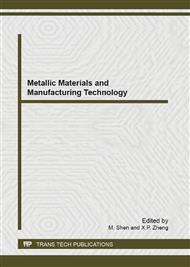[1]
G. Kreysa and M. Schütze. DECHEMA corrosion handbook (DECHEMA revised and extended 2nd Edition, Frankfurt, 2008).
Google Scholar
[2]
D. Smithberg: Inconel 718 machining manual (Manufacturing Research and Development, Boeing Commercial Airplane Company, 1987).
Google Scholar
[3]
S. Miller. Advanced materials means advanced engines: Interdisciplinary Science Reviews Vol. 21 (1996), pp.117-129.
DOI: 10.1179/isr.1996.21.2.117
Google Scholar
[4]
E. O. Ezugwua, J. Bonneya and D. A. Fadareb. Machining of nickel-base, Inconel 718, alloy with ceramic tools under finishing conditions with various coolant supply pressures: Journal of Materials Processing Technology Vol. 162-163 (2005).
DOI: 10.1016/j.jmatprotec.2005.02.144
Google Scholar
[5]
E. O. Ezugwu. Key improvements in the machining of difficult-to-cut aerospace superalloys: International Journal of Machine Tools and Manufacture Vol. 45 (2005), pp.1353-1367.
DOI: 10.1016/j.ijmachtools.2005.02.003
Google Scholar
[6]
G. Poulachon, B. P. Bandyopadhyay, I. S. Jawahir, et al. Wear behavior of CBN tools while turning various hardened steels: Wear Vol. 256 (2004), pp.302-310.
DOI: 10.1016/s0043-1648(03)00414-9
Google Scholar
[7]
X. L. Liu: Cutting Tool and Application of Polycrystalline Cubic Boron Nitride (Heilongjiang Science & Technology Press, Harbin, 1999).
Google Scholar
[8]
J. M. Zhou, H. Walter, M. Andersson, et al. Tool-life and wear mechanisms of CBN tools in machining of Inconel 718: Int. J. Mach. Tools Manuf Vol. 43 (2003), p.301–305.
Google Scholar
[9]
J. P. Costes, Y. Guillet, G. Poulachon, et al. Tool-life and wear mechanisms of CBN tools in machining of Inconel 718: International Journal of Machine Tools and Manufacture Vol. 47 (2007), pp.1081-1087.
DOI: 10.1016/j.ijmachtools.2006.09.031
Google Scholar
[10]
W. Ji, X. L. Liu, Y. F. Li, et al. The Mechanisms of PCBN Tools in Turning GH4169: Advanced Materials Research Vol. 500 (2012), pp.73-81.
DOI: 10.4028/www.scientific.net/amr.500.73
Google Scholar
[11]
T. K. Song, M. Li and H. T. Zhang. Research on the cutting property of polycrystalline carbide boron nitride ( PCBN) tools in turning nickel: Diamond & Abrasives Engineering Vol. 31 (2011), pp.70-73.
Google Scholar
[12]
WenShizhu and Huang Ping. (2008) principles of tribology, Tsinghua university press, pp.80-90.
Google Scholar
[13]
Zhang Hui. (2011) Friction and wear behaviors of hard brittle material sat elevated temperatures, CNKI Shandong University, pp.33-47.
Google Scholar


